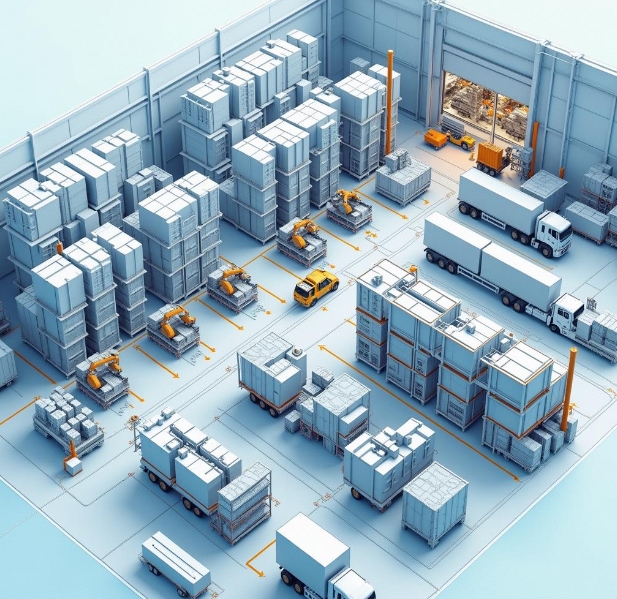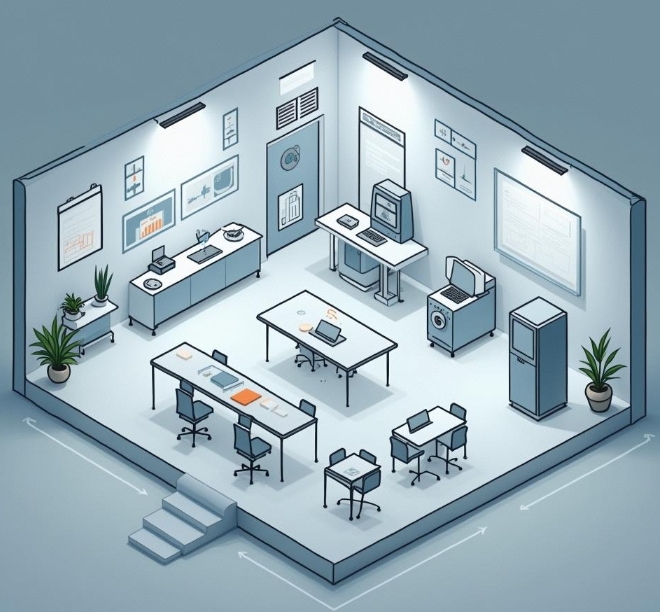Smart Factory Lighting Control Management System: A Key Technology Driving Intelligent Manufacturing
- latest articles
- 1.DApp Development & Customization: Merging Diverse Market Needs with User Experience 2.Analysis of the Core Technical System in DApp Project Development 3.How to achieve cross-chain interoperability in Web3 projects? 4.How does the tokenization of points reconstruct the e-commerce ecosystem? 5.How to Set and Track Data Metrics for a Points Mall? 6.What is DApp Development? Core Concepts and Technical Analysis 7.Inventory of commonly used Web3 development tools and usage tips 8.Development of a Distribution System Integrated with Social E-commerce 9.Six Key Steps for Businesses to Build a Points Mall System 10.What is DApp Development? A Comprehensive Guide from Concept to Implementation
- Popular Articles
- 1.Future Trends and Technology Predictions for APP Development in 2025 2.Analysis of the DeFi Ecosystem: How Developers Can Participate in Decentralized Finance Innovation 3.From Zero to One: How PI Mall Revolutionizes the Traditional E-commerce Model 4.DAPP Development | Best Practices for Professional Customization and Rapid Launch 5.Recommended by the Web3 developer community: the most noteworthy forums and resources 6.From Cloud Computing to Computing Power Leasing: Building a Flexible and Scalable Computing Resource Platform 7.How to Develop a Successful Douyin Mini Program: Technical Architecture and Best Practices 8.Shared Bike System APP: The Convenient Choice in the Era of Smart Travel 9.How to Create a Successful Dating App: From Needs Analysis to User Experience Design 10.From Design to Development: The Complete Process of Bringing an APP Idea to Life
With the acceleration of global industrialization, smart manufacturing has become a significant trend in the development of the manufacturing industry. The construction of smart factories is no longer limited to the automation of production lines but also includes intelligent management of various details. Among these, the lighting control management system, as one of the key technologies in smart factories, plays a crucial role. The intelligent lighting control system not only enhances the factory's energy management but also plays an important role in energy conservation, emission reduction, improving production efficiency, and enhancing employee comfort. This article will delve into the working principles, application scenarios, advantages, and future development trends of the smart factory lighting control management system.
I. Working Principles of the Smart Factory Lighting Control Management System
The lighting control management system primarily uses automation technology and sensor technology to control the lighting equipment within the factory, enabling the lighting system to automatically adjust based on environmental changes, production activities, and other factors, achieving energy-saving, efficient, and comfortable effects. The lighting control management system in a smart factory generally consists of the following key components:
1. Lighting Control Equipment
Lighting control equipment is the core part of the system, including intelligent lighting controllers, dimming devices, and wireless transmission equipment. These devices communicate with sensors and other control equipment via wireless networks or wired connections, monitoring and adjusting the working status of the lighting equipment in real-time. For example, by adjusting the brightness of the lights or turning them on or off to adapt to different working conditions and environmental needs.
2. Environmental Sensors
Environmental sensors are used to detect various environmental changes within the factory. Common types of sensors include light sensors, temperature and humidity sensors, and motion sensors. These sensors collect data such as ambient light intensity and temperature and humidity changes in real-time, transmitting this information to the lighting control system, which then makes corresponding adjustments. For instance, when the ambient light is strong, the system can automatically reduce the brightness of the lights to achieve energy-saving effects.
3. Control System and Data Analysis Platform
The control system and data analysis platform are responsible for comprehensively processing and analyzing the data collected by the sensors. Modern smart factory lighting control management systems often rely on technologies such as cloud computing and big data analysis to aggregate the collected factory environmental data into a centralized management platform for intelligent analysis and decision-making. Through data analysis, the system can identify patterns and issues in lighting usage, further optimizing control strategies and improving the overall energy management efficiency of the factory.

II. Application Scenarios of the Smart Factory Lighting Control Management System
The application scope of the smart factory lighting control management system is very broad, covering almost all industrial sites that require lighting. The following are several typical application scenarios:
1. Production Workshops
In production workshops, workers need adequate lighting to ensure operational accuracy during the production process. However, due to differences in production processes and work modes within the workshop, lighting requirements can vary significantly. The smart factory lighting control management system can dynamically adjust the brightness of the lights based on the actual conditions of the workshop. For example, during equipment maintenance, the system can automatically dim the lights in relevant areas, while during peak production periods, the lights can be automatically brightened to ensure the normal operation of the production line.
2. Warehouse Management
Warehouses, as places for storing raw materials, finished products, and semi-finished products, typically require stable lighting to improve the work efficiency of staff. In traditional warehouses, the lighting system is usually kept on constantly, whereas the smart factory lighting control management system can intelligently adjust based on actual environmental needs. For instance, the system uses motion sensors to determine whether there are workers in specific areas; if no one is working, the lighting system can automatically turn off to save energy.
3. Office Areas
The lighting management needs in office areas differ from those in production areas, focusing more on comfort and energy efficiency balance. In the offices of smart factories, the lighting control system monitors indoor light conditions in real-time using light sensors and automatically adjusts the brightness of indoor lights based on outdoor light intensity, creating a work environment that ensures both the eye health of employees and energy savings. Additionally, the system can automatically adjust lighting modes according to employees' work needs, such as turning on the lights in meeting rooms when meetings start and turning them off after meetings end.

III. Advantages of the Smart Factory Lighting Control Management System
1. Energy Conservation and Emission Reduction
Energy conservation and emission reduction are significant advantages of the smart factory lighting control management system. By using sensors to monitor environmental data such as light intensity and temperature and humidity in real-time, the lighting control system can intelligently adjust the brightness and on/off status of lighting equipment. Especially when there is sufficient natural light, the system can automatically reduce the brightness of the lights or turn them off when no one is present, significantly reducing energy consumption. This intelligent control not only reduces electricity consumption but also lowers the factory's operating costs, contributing to green manufacturing.
2. Improved Production Efficiency
The smart factory lighting control management system can provide more flexible and adaptable lighting solutions for production workshops, warehouses, and other areas. During the production process, when workers need more concentrated lighting, the system can automatically increase the brightness, while during production breaks, the system can automatically reduce brightness or turn off some lights. Such flexibility can effectively improve workers' efficiency. At the same time, appropriate lighting conditions can reduce visual fatigue and enhance employee comfort and production accuracy.
3. Enhanced Safety
In factories, lighting is directly related to the safety of workers. The smart factory lighting control management system can provide real-time safety lighting based on production needs and worker dynamics. For example, in special situations such as nighttime or hazy weather, the system can increase the brightness of lighting in specific areas to ensure that workers can clearly see the production environment and avoid accidents. Additionally, the system can automatically activate emergency lighting in emergencies such as fires or earthquakes, aiding in evacuation.
4. Remote Monitoring and Management
With the development of IoT technology, modern smart factory lighting control management systems can not only achieve intelligent control but also enable remote monitoring and management. Through a cloud platform, managers can view the lighting status of various areas in the factory at any time and from anywhere, promptly identify issues in system operation, and make adjustments and maintenance. This remote management function greatly improves the factory's management efficiency and response speed, reducing the need for manual intervention and maintenance costs.

IV. Future Development Trends
1. Integration of Artificial Intelligence and Big Data
With the advancement of artificial intelligence (AI) and big data technologies, future smart factory lighting control management systems will become more intelligent. By analyzing various data within the factory, the system can proactively identify patterns in lighting requirements during the production process and make predictions and adjustments in advance. The introduction of AI technology will further enhance the system's predictive capabilities, reduce energy waste, and improve production efficiency.
2. Integration with Other Smart Systems
In the future, the smart factory lighting control management system will deeply integrate with other smart systems, such as air conditioning, security, and equipment monitoring systems, forming a highly coordinated smart environment. For example, through integration with the air conditioning system, the lighting control system can automatically adjust the power consumption of lighting equipment based on indoor temperature; when combined with the security system, the lighting control system can automatically activate warning lights upon detecting safety hazards. The high level of system integration will make the entire factory's management more efficient and intelligent.
3. Sustainable Development and Green Manufacturing
As the concept of green manufacturing gains traction, the smart factory lighting control management system will place greater emphasis on sustainable development. In the future, the system will focus more on integrating with renewable energy sources such as solar and wind power, utilizing natural energy from inside and outside the factory to power lighting equipment, further reducing carbon emissions and achieving green operations for the factory.
Conclusion
As an important component of smart manufacturing, the smart factory lighting control management system, with its advantages in energy conservation, environmental protection, improved production efficiency, and employee comfort, has become a key technology driving the development of modern manufacturing. With continuous technological advancements, the smart factory lighting control management system will become more intelligent and efficient, closely integrated with other systems, bringing higher levels of automation and better production environments to factories. In the future, with the ongoing progress of technologies such as artificial intelligence and big data, the lighting control management system will play an even more important role in promoting green manufacturing and improving energy utilization efficiency, laying a solid foundation for the widespread application of smart manufacturing.
-

How to Use App Development to Boost Conversion Rates on E-commerce Platforms
With the widespread adoption of smartphones and the rapid development of mobile ···
-

How APP Development Facilitates Digital Transformation and Innovation
With the rapid advancement of information technology, digital transformation has···
-

App Store Optimization and SEO Strategies in App Development
In today's rapidly evolving mobile internet landscape, apps have become essentia···

 Blockchain
Blockchain










